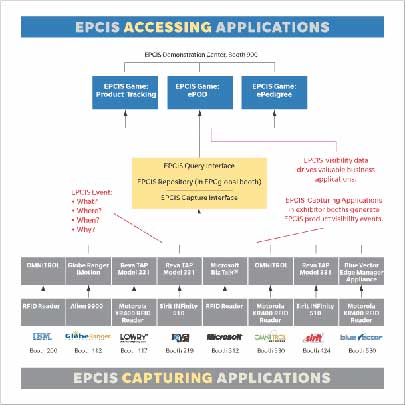EPCglobal‘s Electronic Product Code Information Services (EPCIS) standard, the foundation for global supply chain visibility, defines a standard language for one company to tell another exactly where products and other RFID-tagged assets are located in the supply chain at any particular time. EPCIS is the universal language of “what, when, where and why,” and allows partners to exchange and understand this information even if they have deployed different hardware and software.
To help illustrate how EPCIS works to solve real supply chain business problems, RFID Journal and EPCglobal teamed up in April with eight hardware and software vendors to demonstrate EPCIS technology at RFID Journal LIVE! 2008 in Las Vegas. The experience of creating and running these demonstrations not only showed the great strides vendors of EPCIS-compliant products have made in the year since the standard was ratified, but also exemplified how easy it is for end users to start using it.
|
|
The goal was to provide three demonstrations before a live audience, illustrating how EPCIS is employed in three common supply chain use cases: product tracking, electronic proof of delivery and product tracing (pedigree). Eight exhibitor booths (Blue Vector, GlobeRanger, IBM, Lowry, Microsoft, Omnitrol Networks, Reva Systems and Sirit)—plus the stage where the demos were provided—played the role of nine supply chain trading partners, all connected into a nine-party EPCIS network (see chart on next page).
To simulate a supply chain, we asked two volunteer contestants from the audience to deliver RFID-tagged products to the eight booths, with the rest of the audience playing the role of shipper. As in a real supply chain, the attendees couldn’t physically see the products delivered to the booths (which were far from the stage), but thanks to EPCIS data, they had complete visibility into what was going on in the supply chain. In the proof-of-delivery demonstration, for example, they could determine which contestant delivered his products to the correct location the fastest, and a prize could be awarded.
The remarkable thing about this demo was that it was built and deployed by nine separate teams working independently, integrated using the EPCIS standard just one day before the show began. Each exhibitor booth deployed an RFID interrogator and software or hardware middleware of their choice—the only requirement being that the middleware had to generate data in EPCIS format. As shown in the figure, a variety of commercially available EPCIS-compliant products were used.
Two months before the show, EPCglobal solicited exhibitors to participate. We provided a technical specification explaining how to create EPCIS data incorporating standard business vocabulary and a Global Location Number (GLN) assigned to each exhibitor. These, together with the Electronic Product Codes (EPCs) encoded to the RFID tags on the demo products and time stamps, populate the “what, when, where and why” dimensions of EPCIS data. Apart from such guidelines, each exhibitor was free to design and deploy the reader and middleware infrastructure as they saw fit. Completing the demo setup were an EPCIS repository and demonstration applications I created for EPCglobal, providing visualizations of the EPCIS data for the demo audience.
The experience of setting up a nine-party EPCIS network for LIVE! 2008 was not unlike the process of establishing a true EPCIS network among trading partners. Here are lessons learned, which apply equally to a real-world deployment:
Agree on the data and document it. The EPCIS standard offers a structure, but trading partners must agree on how to populate it. The written specification we provided to exhibitors in advance, including many examples, was the key to success.
Click here to view a larger version of the chart.
Provide self-service testing. One month prior to the event, I deployed a test server where each exhibitor could send EPCIS data and have it played back, with an error message displayed if that data was out of spec. Trading partners could thus work out problems before final integration began.
Synchronize your clocks. When you bring EPCIS data together, it won’t make sense if each trading partner’s clock is set differently. At LIVE!, we needed to address this issue, as exhibitors brought equipment from different time zones and, in some cases, forgot to reset it.
Use test data, but keep it separate from real data. We conducted many tests at the show to make sure each exhibitor was generating EPCIS data properly. In a production setting, it is important to separate this test data from real information. Test data is not just utilized during initial integration—even after a trading partner is online, expect to periodically run test data to confirm the system continues to operate correctly.
Establish strong lines of communication with your trading partners. You may care more about the data you receive from your partner than he does, so it’s important to have a point of contact if you suspect the information is not coming through properly. At the event, one booth stopped transmitting data five minutes before demo time because somebody unplugged the reader to charge his cell phone. That person wasn’t looking at the data himself, so he didn’t realize he had done anything wrong.
Keep it simple. Completing a nine-way integration in one day may sound complex, but it worked because the underlying design was simple and clearly understood by all parties involved. The EPCIS standard is fundamentally simple and solid, and sticking to it dramatically reduces the technical risk.
One year ago, it might have seemed impossible to deploy a nine-party supply chain visibility network with only two months’ preparation time and one day of integration. EPCIS technology and commercial products have matured to the point, however, where such a goal is not only possible, but easily achieved. If you thought EPCIS was too difficult to set up and use, then now is the time to take another look.
Ken Traub, an independent consultant specializing in enterprise software architecture and EPC RFID standards, is the editor of the EPCIS specification.



